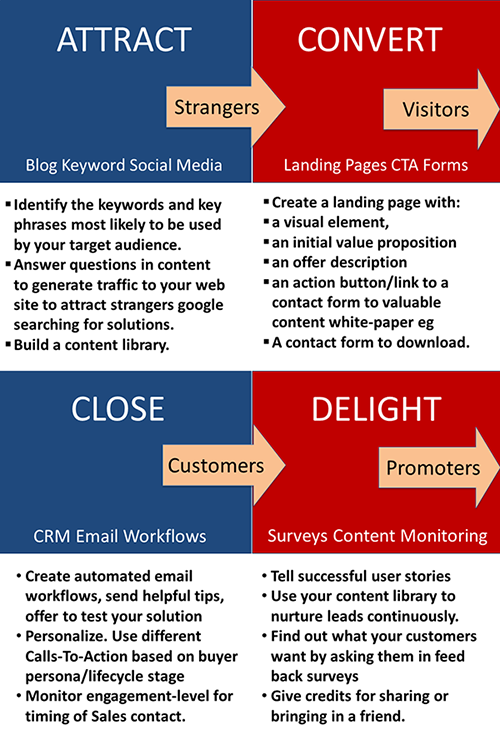The inbound marketing methodology empowers businesses to attract visitors, convert leads, close customers, and keep them delighted and engaged with your business. However, mastering the art of inbound marketing takes a lot of work.
Attract with Keyword Targeting, Your Blog, Social Media. Developing a marketing strategy designed to convert leads, along with having the right content on your site, is key to turning those leads into customers and achieving an optimal ROI. Using Persuasive Content and Calls-to-Action to Convert Visitors into Leads.
Pull Marketing, Inbound Marketing, is about attracting buyers online at the moment they become interested instead of when sellers want to sell. Inbound marketing focuses on earning, not buying, a person’s attention, which is done through social media and engaging content, such as blogs, podcasts and white papers. This content is interesting, helpful and adds value, creating a positive connection and trust in the eyes of the consumer, thus making him more likely to engage with your brand.
This requires a mindshift in the marketing and sales organization from linear push thinking strategies to interactive pull strategies built on permission and consent.
Social business is about building and nuture relations and a signal to track is engagement. As a Marketer, think as your role as a Publisher and Sales comes in when engagement level is high as a advisor.
4 Stages of the Inbound Methodology

The inbound marketing methodology empowers businesses to attract visitors, convert leads, close customers, and keep them delighted and engaged with your business. However, mastering the art of inbound marketing takes a lot of work.
There are four levels of strategy in the methodology:
1. Attract
2. Convert
3. Close
4. Delight
What is the difference between outbound and inbound marketing?
Outbound marketing refers to any kind of marketing where a company initiates the conversation and sends its message out in paid channels to an audience. Outbound marketing is the opposite of inbound marketing, where the customers find you when they need you through googling questions or checking social forums and recommendations online.
Inbound marketing tactics are more concerned with establishing a presence that naturally invites people to your organization, usually through helpful valuable content.
Traditional single-click push marketing, based on the strategy “Outbound Marketing”, with a market mix of ads, TV and radio advertising, telemarketing and direct mail becomes less effective when attention can no longer be purchased in controlled communication channels. Push marketing interrupts the consumer when sellers want to sell, which does not match the consumer’s new buying and decision-making process at all.
– Common problems with outbound marketing:
– Difficulty in tracking return on investment (ROI)
– Increasing blocking techniques (Do not call list, Spam filters, TiVo, etc)
– High cost, low yield.
In inbound sales companies base their sales process by monitor buyer actions, they align sales and marketing and creating a seamless experience for buyers.
The cost of Inbound Marketing is 60 percent lower than for Outbound Marketing, show research.
What’s the challenges with Inbound Marketing?
The challenge for the organization is to adapt the approach and organization from a push thinking to a pull strategy. In order to match the new customer power, a smooth interaction is required internally between marketers and sellers. Strategic initiatives need to focus on the relationship first and the transaction since. Not the other way around.
Compare two sales strategies based on different approaches and expectations of sales people and marketers. It often causes conflicts internally:
Push – Traditional Campaign Push. A campaign fixes the sale. Focus: Find the need to “convert” multiple transactions.
Pull – Relationship When Customer Will Pull. Needs develop over time on consumer terms. Focus: Buying happens when consumers and networks wish, not when the seller wants to sell. Therefore, relationship strategies are required.
How does the new Marketing Logic affect Marketing and Sales strategies? In the digital transformation era two mindsets often causes conflicts.
Mindset 1.
Traditional push sales are based on the sender receiver idea. The transaction is in a one-time transaction and the customer is called internally for conversion. What happens before and after the moment of purchase is not relevant to the deal. This approach is badly adapted to the network economy. Large resources are invested in push activities, but not customer dialogue in social media.
Mindset 2.
Trend sales are based on long-term relationship strategies. By gaining confidence and commitment in social networks, the business is built up in the long term. Listen to when the individual’s commitment and interest is at its peak, only then a seller can contact to tell you more. Pull sales save time and resources both for the individual and for the company.